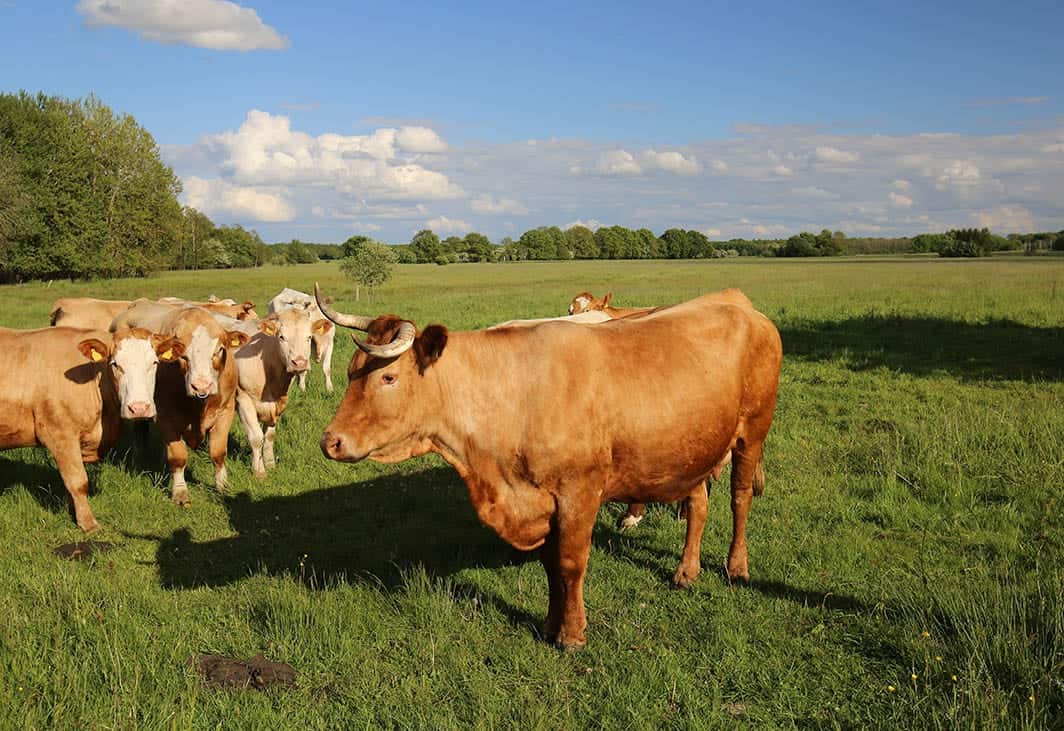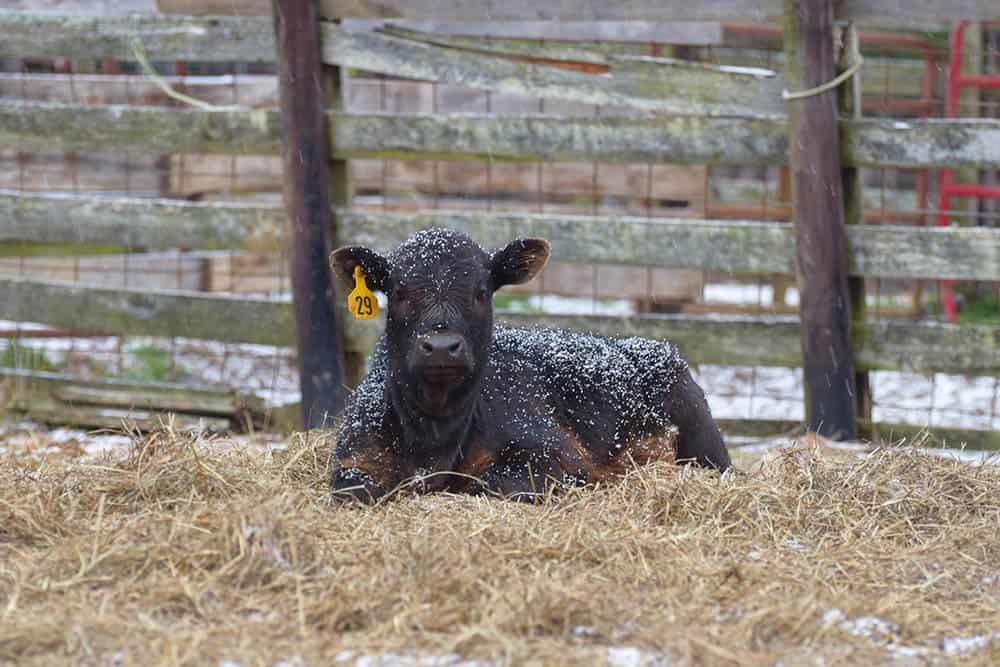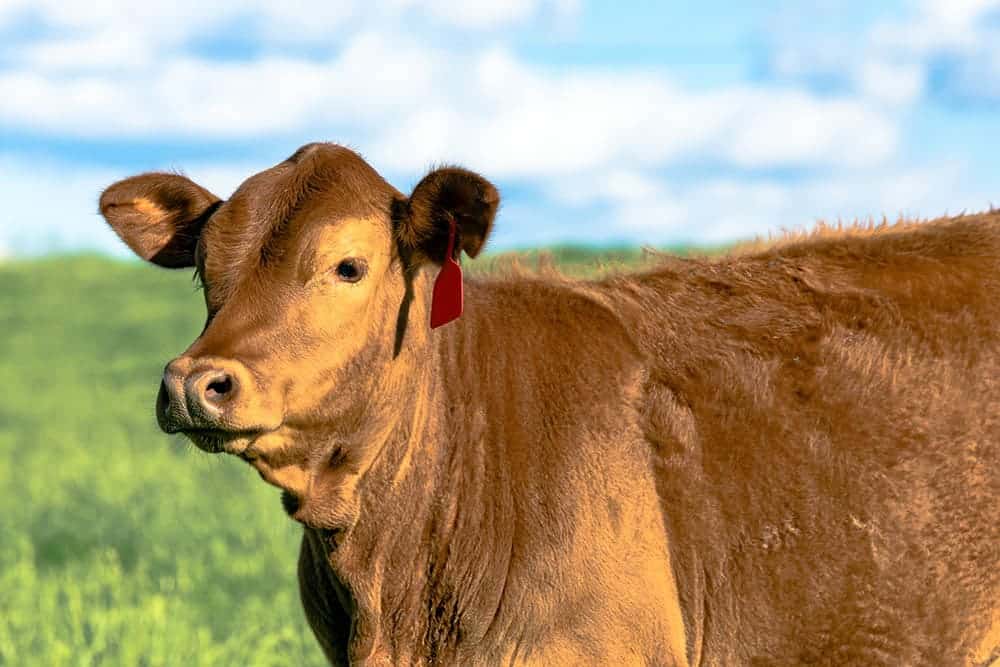The Gelbvieh (pronounced Gelp-fee, with a hard “g” sound) are cattle that were developed for their meat, milk, and as draft animals in southern Germany in the 1850s.
Gelbvieh cattle have many advantages over other cattle breeds, so let’s go over basic information, characteristics, and interesting facts about them.

Quick Facts about Gelbvieh Cattle
| Breed Name: | Gelbvieh or Yellow Cow |
| Place of Origin: | Bavaria, Germany |
| Uses: | Meat, milk, draft |
| Bull (Male) Size: | 2,200 lbs. |
| Cow (Female) Size: | 1,600 lbs. |
| Color: | Yellow to black to red |
| Climate Tolerance: | Most climates |
| Care Level: | Easy |
| Production: | Good for both meat and milk production |
| Fertility: | Exceptional |
Gelbvieh Cattle Origins
The Gelbvieh breed was bred initially in three Franconian districts of Bavaria around 1850. It was developed from strains of the local Red-Yellow Franconian cattle, and by 1870, it had become a triple-purpose breed for draft, milk, and meat.
For roughly 100 years, you could only find Gelbvieh cattle in Germany, but in the early 1970s, they were introduced to North America through their semen and Australia by the late 1970s.


Gelbvieh Cattle Characteristics
Gelbvieh are docile and quiet, which means they are easy to handle and tend to be less stressed than most other breeds.
Their skin is fully pigmented, which makes them adaptable to hot climates. Australia and South Africa have reported that Gelbvieh have shown tolerance to both heat and ticks. But Gelbvieh have also done well in the colder climates of the United States and Canada.
Additionally, the Gelbvieh breed has the earliest puberty out of all other beef breeds. This means they can be used for breeding by 1 year of age and can calve by 21 months (compared to more than 24 months for other breeds).
These cattle are quite fertile. The males have large testicles, which leads to the females being more fertile than most other breeds. The females also show excellent maternal instincts, and they produce high-weaning weights — their calves are typically 440 pounds by 7 months of age. They also have exceptional milking abilities and udders.
Gelbvieh are used extensively in crossbreeding programs to help improve other breeds’ quality. Specifically, the quality of the carcass, weaner weights, and fertility abilities are all selling points for hybrid programs.
Uses
Gelbvieh cattle were initially used for draft work, milk, and meat. They are more commonly used today just for their meat. It tends to be a lean breed, and that combined with their fast growth rates means its meat can be a young and tender beef.
This breed provides exceptional meat when Gelbvieh bulls are crossbred with Angus females (the outcome is known as Balancer cattle). It is also known to have high cutout yields, with some of the largest ribeye muscle areas compared to most other breeds.
Appearance & Varieties
The word “gelbvieh” translates to “yellow cattle” in German. This is due to the breed’s origins with the Red-Yellow Franconian breed. The Gelbvieh has short and fine hair with strong skin pigmentation, and it can range from black to a russet or a reddish-gold color.
About 40 years ago, Gelbvieh were more of a golden-brown and had horns, but today, they come in the current variety of colors and are polled (bred to not have horns).
They are medium to large in size, with the bulls averaging 2,200 pounds and the cows 1,600 pounds.
Distribution/Habitat
Since the Gelbvieh is such an adaptable breed for a variety of climates, it can be found in Europe, Australia, the United States, Canada, and Africa.
It was found that other breeds prefer to avoid the heat of the sun, such as most European and British breeds, by seeking out the shade. But the Gelbvieh tends to stay in the sun and seems comfortable doing so.


Are Gelbvieh Cattle Good for Small-Scale Farming?
Gelbvieh cattle can be kept in both small and large herds, and their quiet temperaments make them less likely to become stressed and therefore, are easy to care for.
They are also crossbred quite frequently, so the Gelbvieh can easily be kept with other breeds, and its resistance to heat and ticks means it’s a healthy breed. Plus, it is one of the most efficient breeds with respect to its feed conversion efficiency.
The Gelbvieh are excellent cattle for many reasons, so they definitely will be a great fit on just about any farm.
Related cattle reads:
Featured Image Credit: JNix, Shutterstock
